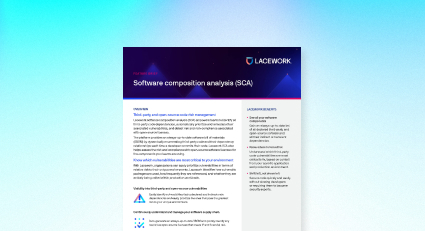What is an SBOM (software bill of materials)?
Table of contents
The value of SBOMs SBOM implementation SBOM formats and standards How SBOMs impact cybersecurity SBOMs in regulated industries The benefits of SBOMsAn SBOM, or software bill of materials, is an exhaustive list that details every component and dependency that goes into creating a software application. This includes all elements, from open-source libraries and frameworks to modules, along with their specific versions used in the development process. The primary purpose of an SBOM is to improve transparency and clarity into the software supply chain, enabling companies to better manage the security, compliance, and licensing risks associated with their software assets.
Understanding the value of SBOMs
In today's digital age, securing the software supply chain is a paramount concern for organizations. A key part of this security involves the utilization of software bill of materials (SBOMs). These resources provide an in-depth analysis of the foundational elements that compose software, including components from open source and third-party providers, libraries, and frameworks.
SBOMs enhance supply chain transparency and visibility, enabling organizations to effectively manage security risks. They facilitate the identification of vulnerabilities, tracking of patch levels, and assurance of compliance with licensing requirements. By understanding the software’s components in detail, organizations can prioritize their efforts based on the criticality of these components, leading to efficient resource allocation.
Moreover, SBOMs are crucial to compliance and auditing processes. Maintaining an accurate and current SBOM helps demonstrate compliance with licensing obligations and regulatory requirements, reducing legal risks and enhancing the organization's reputation.
In conclusion, SBOMs are essential tools for securing the software supply chain. By adopting SBOMs, organizations can proactively manage vulnerabilities, mitigate risks, and ensure compliance, thereby strengthening their software supply chain security and building trust with their customers and partners.
Implementing SBOMs in your organization
The implementation of SBOMs (software bill of materials) can significantly boost your software supply chain security and strengthen your overall risk management strategy. SBOMs provide a detailed inventory of all the components and dependencies used in your software, enabling the identification and mitigation of potential vulnerabilities effectively.
Here are some steps to build an SBOM:
1. Identify all software components used in your organization, including both proprietary and third-party software.
2. Document each component's details, such as the name, version, and licensing information for effective vulnerability tracking and management.
3. Establish a process to maintain an updated SBOM. Regularly review and update the inventory as software components are added or removed.
4. Integrate your SBOM with vulnerability management tools to automate vulnerability identification and remediation.
While the adoption of SBOMs can be beneficial, it does come with challenges, such as a lack of awareness about SBOMs, complexity in building and maintaining an accurate SBOM, and managing third-party software and their associated vulnerabilities. However, these challenges can be addressed effectively with proper education, automation, and collaboration with vendors, significantly improving software supply chain security and minimizing potential vulnerabilities.
Understanding SBOM formats and standards
There are several commonly used formats for documenting and managing software components when it comes to software bill of materials (SBOMs). Common formats include SPDX (Software Package Data Exchange), CycloneDX, and SWID (Software Identification). Each of these formats serves a unique purpose and offers different benefits.
Understanding SBOM standards is equally important. Widely adopted standards include the NIST SBOM Framework and the CDF SBOM Specification. The choice of format and standard depends on various factors, such as the complexity of your software ecosystem, the level of collaboration required, and the industry standards you need to comply with. It's essential to evaluate your organization's specific needs and goals to make an informed decision.
Enhancing cybersecurity with SBOMs
Software bill of materials (SBOMs) play a crucial role in bolstering cybersecurity. They offer transparency and visibility into the software supply chain, enabling organizations to identify and address potential security risks proactively. SBOMs contribute significantly to vulnerability assessment, allowing organizations to identify any known vulnerabilities or weaknesses in their software and take appropriate measures to mitigate these risks. SBOMs provide valuable insights into the origin and composition of the software components used in your organization, helping to maintain the integrity and security of your systems.
The role of SBOMs in regulated industries
In highly regulated industries, software bill of materials (SBOMs) play a key role by providing a comprehensive inventory of the software components used in an application or system. This detailed documentation helps meet the specific requirements set by regulatory bodies, ensuring compliance with regulatory guidelines. Furthermore, adopting SBOMs brings significant compliance benefits, allowing organizations to track and manage software supply chain risks effectively. With an accurate and up-to-date SBOM, potential vulnerabilities can be identified proactively, mitigating security risks. The effectiveness of SBOM adoption is evident from real-world case studies from regulated industries, where SBOMs have successfully helped identify vulnerabilities and ensure compliance, thereby safeguarding sensitive data.
The benefits of embracing SBOMs
Software bill of materials (SBOMs) have become increasingly important for organizations to ensure the security and integrity of their software supply chains. Using SBOMs can offer numerous benefits, including complete visibility into the components and dependencies of your software, allowing for effective identification and mitigation of vulnerabilities. Obtaining an SBOM is a straightforward process that can be accomplished by working with vendors (like Lacework) or by using open-source tools to generate an SBOM for your own software.
SOLUTION BRIEF
Lacework software bill of materials (SBOM)
Interested in seeing an SBOM in action? See why the Lacework platform approach to SBOM can help you maintain application security for the long haul.
Access the brief
This article was generated using automation technology. It was then edited and fact-checked by Lacework.